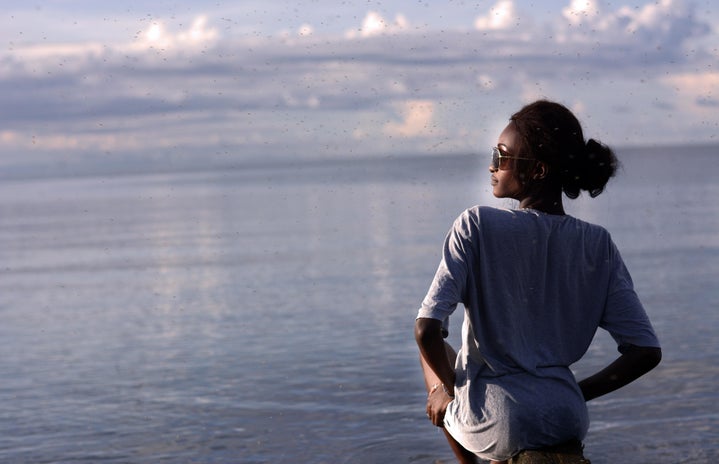**Warning, sensitive topics about mental health and suicide.**
This past Thursday I wore green beads because I struggle with depression and have attempted suicide. I wore purple beads for the loss of a family friend who committed suicide his sophomore year at ASU during a bipolar episode. I wore teal beads because I have friends who are struggling with depression and anxiety; Because they have me to lean on when their mental health takes a toll on them. I wore blue beads because I whole-heartedly support suicide prevention
Photo Courtesy of Jessica Vernone
Suicide is the second leading cause of death among college students, right behind vehicular accidents. Every 12.8 minutes someone dies of suicide in America, that’s approximately 129 people a day. Depression is one of the most easily treated psychiatric diseases, with 80 to 90 percent of patients reacting positively to treatment.
“Ninety percent of all people who die by suicide have a diagnosable psychiatric disorder at the time of their death,” says the AFSP website.
So, if these psychiatric disorders are diagnosable and treatment for depression is so effective, then why are we still losing approximately 47,085 people a year to suicide? What are people who suffer from depression and other mental illnesses doing to cope with their struggles? And what is our school doing for its students?
Photo Courtesy of Hratch Avetisyan
Personal Struggles
During the Out of the Darkness walk, the crowd of students was littered with green beads, representing their own struggle with mental illness and suicide. Twenty-five million Americans suffer from depression each year and we are so focused on our own selves and our own struggles that we forget that there are millions of people out there going through their own battles.
Everyone copes with their struggles in their own way, some turn to self-harm which has resulted in approximately 495 thousand people visiting a hospital for injuries due to self-harm every year “suggesting that approximately 12 people harm themselves (not necessarily intending to take their lives) for every reported death by suicide,” says the AFSP website.
The first step of being able to get help and find your coping mechanisms is to realize that there is a problem. You need to address it if you want to reach out to get help.
Photo Courtesy of Hrach Avetisyan
“Honestly, it’s been quite the journey. Definitely one of the first things that I realized was just admitting that there is something and that something is depression. Sometimes people, and I did this a lot, were just like ‘no I’m just having an off day, I’m just feeling sad,’ but realizing that you do have this is a good way to go about it because then you can find resources to help,” said Summer Pasquale, a student who wore green beads at the walk.
The goal, when you’re struggling with your internal battle, is to find a healthy coping mechanism that is safe and effective. From artistic outlets to using sports or just going to therapy, there is always going to be a healthy outlet that can help you.
Photo Courtesy of Jessica Vernone
“I found a good way to overcome it, for me, was to start writing poetry, kinda get my thoughts out, let everything out,” said Michael Rodriguez, a student who wore green beads as well. “And then once I had everything out, then I started to kind of feel more at home with myself and feel more comfortable.”
For some, artistic expression isn’t always the way to go. Some people find seeking out help from a therapist or just a friend lending an ear is the best way to cope for them.
“One of the things that I do is just; like one I do see a therapist just to help me process through the feelings I have because sometimes I know that another coping mechanism I have is talking to my friends but I know that they may not be able to help me the way that a professional could,” said Pasquale. “So definitely just having those resources, my friends and the mental health counselors and professionals.”
People who haven’t been diagnosed were still wearing green beads because whether they sought help or not they still struggled and their struggles are still valid.
Photo Courtesy of Jessica Vernone
“I think it’s important to take care of ourselves, so practice self-care whether that’s going on a walk around campus or even just taking some time to sleep,” said Cecilia Leon, a student who has struggled with mental health. “I think for me I just like to write and talk about it to other people and not try to stigmatize mental health. So just being able to be open to talk about it is what helps me so far.”
Campus Resources
“Don’t be afraid to ask for help, there are so many resources here on campus, and we’re here to support you,” Leon says.
Sacramento State’s President Nelsen and his wife Jodi have lost their son to suicide, and they are very active about suicide awareness. They make sure Sacramento State has plenty of resources and help for their students to prevent any other parents from experiencing the pain of losing a child.
Photo Courtesy of Jessica Vernone
“Another way to start is looking for counselors, therapists around the area. Even at Sac State, they have the well, which is a really great resource here that a lot of students may not realize,” said Pasquale. “So definitely going there and getting the help you need, get short term therapy and then when you have that friend after therapy you can be like ‘hey I just got back, can we do something to help either process through this or help me feel better.”
Sacramento State offers Counseling and Psychological Services (CAPS) to help students who are in need. This program offers therapists that you can see for eight to nine sessions a semester, group counseling for students who want to connect with others in similar situations and you can make an appointment at The WELL to see a primary care physician if you think that medication would help you.
“I’d just like to say that it’s not the end and you should never feel like you’re a burden on someone else. You should always try to live life in a way that you feel happy,” Rodriguez says.
Photo Courtesy of Jessica Vernone
If you or a loved one are suffering from a mental illness and you would like to seek help, check out the Sac State Red Folder for resources.
If you are experiencing suicidal thoughts, call the Suicide Prevention Lifeline at 1-800-273-TALK(8255).
If you are in immediate danger, call 9-1-1.


